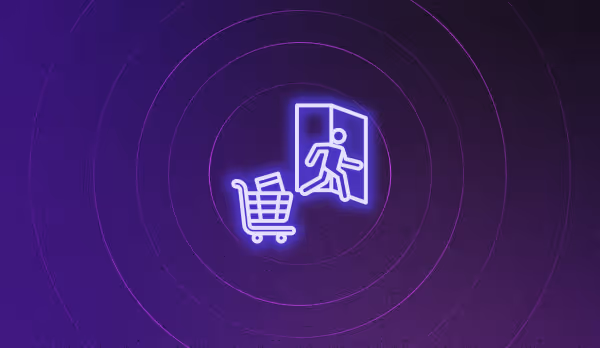Reclaiming lost revenue: Strategies for reducing shopping cart abandonment rates


In the fast-paced world of ecommerce, digital shopping carts fill up rapidly with potential purchases. Yet, a significant proportion of these carts never make it to the checkout line. This phenomenon, known as shopping cart abandonment, represents a significant revenue loss for ecommerce stores.
As the ecommerce industry continues to grow, with global retail ecommerce sales expected to reach $6.31 trillion in 2023, so does the potential for revenue loss due to cart abandonment.
Cart abandonment is akin to customers walking into a brick-and-mortar store, filling their shopping baskets with items, reaching the cashier, and then abruptly leaving, never to return. For the business owner, it's a bewildering and frustrating scenario. This critical juncture, where potential revenue morphs into a lost opportunity, has become a hotbed for analysis, innovation, and strategic planning.
The following article provides a detailed analysis of online shopping cart abandonment, delving into its causes, impact on revenue, and effective strategies for everyone who wants to know how to reduce shopping cart abandonment.
Common reasons for cart abandonment

Seeing these reasons for cart abandonment as serious ecommerce errors will help you identify the pain points in the purchasing journey that dissuade customers from completing their purchases.
- Unexpected costs: Hidden costs that customers encounter at the checkout stage can take various forms, such as costs of shipping, taxes, and handling or service fees. If a customer perceives these extra costs as too high or feels blindsided by them, they are likely to abandon their cart.
- Mandatory account creation: Mandatory account creation can disrupt the fluidity of the customer experience. A customer's desire to make a quick purchase can be hampered by the need to spend time creating an account. In fact, research by the Baymard Institute found that 24% of customers abandoned their cart because the site wanted them to create an account.
- Complicated checkout process: A checkout process that's too complicated or time-consuming is a major deterrent. Long forms to fill, unclear navigation, slow load times, or too many steps can frustrate customers and lead to abandonment. The same research suggests that 17% of online customers have abandoned an order during the checkout process because it was too long or complicated.
- Security concerns: In an era where data breaches are becoming increasingly common, customers are understandably concerned about the security of their personal and financial information. If your website doesn’t clearly demonstrate that it is secure, customers may abandon ecommerce shopping carts. Trust signals such as SSL certificates, well-known payment gateways, and visible privacy policies can help alleviate these concerns.
Cart abandonment statistics
The impact of cart abandonment on ecommerce can't be overstated. It represents a major hurdle to optimal conversion rates and has significant implications for lost revenue.
According to the comprehensive report by the Baymard Institute mentioned above, the average cart abandonment rate documented online is approximately 69.99%. In simpler terms, seven out of ten online shoppers leave without completing their purchase, which underscores the extent of the problem and the potential for cart recovery.
Further highlighting the financial impact, data suggests that ecommerce businesses lose approximately $18 billion per year due to abandoned carts. This colossal figure speaks volumes about the magnitude of the problem and the monumental opportunity it presents for revenue recovery.
Optimizing the checkout process
A significant portion of your potential customers reaches the checkout process, signaling a strong intent to purchase. However, checkout can be a make-or-break point in the customer journey. Hence, optimizing this process is critical in decreasing your cart abandonment rate, which is one of the main ecommerce KPIs.
Strategies for optimizing the checkout process
Optimizing the checkout process involves making strategic changes that simplify and streamline the process, enhancing user experience, and thereby encouraging customers to complete their purchase.
- Simplify the checkout flow: Minimizing the number of form fields and steps required to complete a purchase makes the process more customer-friendly and less likely to cause frustration or impatience.
- Offer guest checkout options: This allows users to make a quick purchase without the need for account creation, which can significantly reduce friction and lower abandonment rates.
- Provide multiple payment options: By offering a variety of options including debit/credit cards, PayPal, Apple Pay, Google Pay, and others, you cater to a broader audience and increase the likelihood that customers can pay as they prefer.
Etsy offers multiple payment options including credit/debit cards, PayPal, Apple Pay, Google Pay, and even Etsy Gift Cards. This variety ensures that most customers can pay in their preferred way, reducing the likelihood of cart abandonment due to payment-related issues.
- Transparent pricing: Be upfront about any additional costs, such as shipping costs or taxes, early in the process. Transparency in pricing helps build trust and reduces the likelihood of customers feeling blindsided at checkout, which could lead to abandonment. Alternatively, provide free shipping if possible.
Warby Parker, an online glasses retailer, provides a commendable example of transparent pricing, with a flat-rate pricing model and no additional shipping charges. Prices on product pages are the final prices that customers pay.
Testing and analyzing the checkout process
Implementing changes is just the beginning. It's crucial to continuously test and analyze the effectiveness of the checkout process.
- A/B testing allows you to experiment with different elements to identify what resonates best with your audience.
- Heat mapping can also provide valuable insight into customer behavior during the checkout process.
- Tools like UserTesting allow real users to interact with your website while providing feedback.
- Different customer segments might behave differently during the checkout process. Analyze behavior based on customer demographics, source of traffic, and type of product to gain deeper insights.
- If customers are abandoning their carts, a simple email survey or popup can provide valuable insight into their reasons for not completing a purchase.
Building trust and reducing friction

One significant challenge of ecommerce is the lack of physical interaction, which means building trust with customers becomes more complex. Additionally, any hurdles encountered during the online shopping experience, often referred to as friction points, can easily deter customers.
Building trust
In an age of data breaches and online fraud, customers need assurance that their personal and financial information is secure. Displaying security badges prominently on your website, particularly during the checkout process, can reassure customers. These could include SSL (Secure Sockets Layer) certificates, or badges from well-known internet security companies like Norton, McAfee, or TRUSTe.
Trust can also be built by showcasing social proof like positive customer testimonials, customer reviews, or ratings. According to a consumer review survey by Bizrate Insights, 54.7 percent of customers read at least four product reviews prior to purchasing a product. Highlighting these positive endorsements can reassure potential customers of your product quality and customer service.
Moreover, clear and comprehensive product details, along with high-quality images or videos, can help customers make informed decisions, reducing the chances of post-purchase dissonance and returns, and increasing the likelihood of successful transactions.
Apple provides a stellar example of building trust with its customers. They ensure the entire shopping experience, from browsing products to checkout, is secure. The site uses HTTPS, indicating that all data transferred is encrypted and secure. Additionally, the payment process is streamlined and secure, with Apple Pay as a payment option, reducing the need for customers to enter credit card details.
Apple also extensively showcases customer reviews and ratings for its products. This transparency not only allows potential buyers to make informed decisions but also builds trust in the quality of their products.
Reducing friction
Friction in the ecommerce context refers to anything that hampers the smooth flow of the customer journey, from browsing to purchase. It could be slow website speed, poor navigation, lack of product information, complicated checkout processes, or limited customer support.
Addressing these friction points involves improving website design and functionality, providing detailed product information, simplifying the purchase process, and offering efficient customer support.
A customer-centric return policy can also reduce friction. If digital buyers know they can easily return a product if it doesn't meet their expectations, they may be more likely to complete the actual purchase.
Zappos, the online shoe and clothing retailer, is a leading example of reducing friction in the ecommerce journey. The website is user-friendly, with intuitive navigation, clear categories, and a robust search function that makes finding products easy.
Moreover, they offer a simplified checkout process with minimal steps, guest checkout option, and multiple payment methods, all contributing to a frictionless user experience. But where Zappos truly shines is in its customer-centric return policy. They offer a 365-day return policy with free shipping both ways, giving customers peace of mind and reducing the perceived risk of purchase.
Recovering abandoned carts
While preventive measures to decrease cart abandonment are crucial, it's equally important to have strategies in place for recovering online carts that do get abandoned.
Strategies for recovering abandoned carts and reclaiming lost revenue
Recovering abandoned carts essentially involves re-engaging with customers who have shown a clear intent to purchase.
- Retargeting ads: Retargeting ads allow you to display personalized ads to users who have visited your website but left without making a purchase. These ads, displayed on various platforms such as social media or other websites the user visits, act as reminders of the items left in the cart, prompting customers to return and complete the purchase.
- Abandoned cart emails: These are personalized emails sent to customers who abandoned their carts, reminding them of their unfinished purchase. Cart abandonment emails can be simple reminders or offer incentives like a discount code, coupon code, or free shipping options to entice customers to complete their purchase.
Casper, an online mattress retailer, sends out a well-designed cart recovery email. The email is simple, reminding the customer of what they left behind and showcasing the benefits of their product. They also add a bit of humor to keep the tone light and friendly, asking “Did you forget something?”. This kind of personalized email helps reconnect with customers and encourages them to complete their purchase.
- Exit-intent popups: These are messages that appear when a user is about to leave your website, offering incentives or assistance to encourage them to stay and complete their purchase.
- Live chat support: Offering real-time assistance through live chat can address any questions or concerns that may be causing the customer to abandon their cart. Having questions answered by a live person during an online purchase is one of the most important features a website can offer.
Implementing these strategies can help re-engage customers, address their concerns, and guide them towards completing their purchase, thereby helping you reclaim lost revenue.
Reclaiming lost revenue leads to a better bottom line
Cart abandonment is a persistent and common problem in ecommerce, leading to significant revenue loss. However, with a detailed understanding of its causes and a strategic approach to address them, online businesses can successfully reduce abandonment rates, reclaim lost revenue, and enhance their customer's shopping experience.
While this article outlines several effective strategies, it's essential to remember that every ecommerce business is unique. Therefore, make sure to combine data analysis, customer feedback, and constant testing to tailor these strategies to your specific needs and audience.
Remember, the goal is not just to recover lost sales but to create an efficient, customer-friendly shopping process that builds trust and loyalty. The focus should always be on the customer's journey and ecommerce experience, leading not only to immediate sales recovery but also to long-term business growth through repeat customers.




